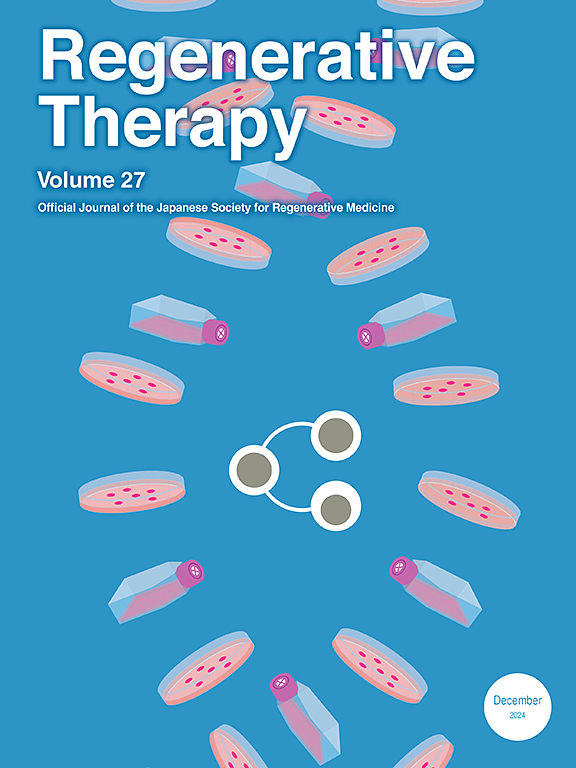犬诱导多能干细胞衍生间充质干细胞的生成:分化策略和细胞来源的比较
IF 3.5
3区 环境科学与生态学
Q3 CELL & TISSUE ENGINEERING
引用次数: 0
摘要
间充质干细胞(MSCs)具有免疫调节潜能,被用于人类和兽医学的细胞治疗。然而,供体来源的MSCs具有有限的增殖活性和变异,这限制了它们的临床应用。相比之下,诱导多能干细胞(iPSCs)可以无限自我更新并分化为三个胚层。利用这些特性,iPSCs可以分化为间充质干细胞(iMSCs),并有可能克服供体来源的间充质干细胞的局限性。据报道,在人类中,根据iPSCs的分化策略和细胞来源,iPSCs的特征会有所不同。然而,尚未有研究调查犬iPSCs (ciPSCs)的分化策略和细胞来源与iMSC生成的关系。方法通过中胚层和外胚层将扫描得到的胚胎成纤维细胞来源的iPSCs (CEF-iPSCs)分化为iMSCs,观察其增殖能力和CD34、CD44、CD45、CD90的表达水平。然后,我们通过外胚层将iMSC诱导方法应用于其他ciPSC系,包括犬真皮成纤维细胞衍生的iPSCs (CDF-iPSCs)、犬外周单核细胞衍生的iPSCs (cPBMC-iPSCs)和犬尿源性细胞衍生的iPSCs (ccu -iPSCs)。我们评估了它们的增殖、标记表达和向三系分化的能力,并进行了比较分析。结果CEF-iPSCs经外胚层诱导获得的simscs比经中胚层诱导获得的iMSCs具有更高的增殖能力和更高的MSC标志物表达率。值得注意的是,除了CDF-iPSCs外,其他ciPSC系通过外胚层谱系成功生成了iMSCs。这些iMSCs在传代10时表现出增殖活性,表达MSC标记物,并表现出向三谱系分化的能力。与其他iMSCs相比,ccu - ipscs衍生的iMSCs表现出最高的CD90表达。结论ccu - ipscs经外胚层诱导可获得高增殖率的间充质干细胞。我们的研究表明,ciPSCs的分化策略和细胞来源在iMSCs的产生中起着至关重要的作用。本文章由计算机程序翻译,如有差异,请以英文原文为准。
Generation of canine induced pluripotent stem cell-derived mesenchymal stem cells: Comparison of differentiation strategies and cell origins
Introduction
Mesenchymal stem cells (MSCs) possess immunomodulatory potential and are used for cell therapy in both human and veterinary medicine. However, donor-derived MSCs have limited proliferative activities and variations, which restrict their clinical applicability. In contrast, induced pluripotent stem cells (iPSCs) can self-renew indefinitely and differentiate into the three germ layers. By exploiting these characteristics, iPSCs can differentiate into mesenchymal stem cells (iMSCs) and potentially overcome the limitations of donor-derived MSCs. In humans, the characteristics of iMSCs have been reported to vary depending on the differentiation strategy and cell origin of iPSCs. However, no studies have investigated the differentiation strategies and cell origins of canine iPSCs (ciPSCs) in relation to iMSC generation.
Methods
Canine embryonic fibroblast-derived iPSCs (CEF-iPSCs) were differentiated into iMSCs via the mesoderm or ectoderm, and their proliferative ability and the expression levels of CD34, CD44, CD45, and CD90 were assessed. We then applied the iMSC induction method via the ectoderm to other ciPSC lines, including canine dermal fibroblast-derived iPSCs (CDF-iPSCs), canine peripheral mononuclear cell-derived iPSCs (cPBMC-iPSCs), and canine urine-derived cell-derived iPSCs (cUC-iPSCs). We assessed their proliferation, marker expression, and ability to differentiate into tri-lineages and performed comparative analyses.
Results
IMSCs derived from CEF-iPSCs via the ectodermal lineage showed higher proliferative ability and expressed MSC markers at a higher rate than iMSCs generated via mesodermal induction. Notably, with the exception of CDF-iPSCs, iMSCs were successfully generated from other ciPSC lines via ectodermal lineages. These iMSCs exhibited proliferative activities over passage 10, expressed MSC markers, and demonstrated the ability to differentiate into tri-lineages. iMSCs derived from cUC-iPSCs exhibited the highest expression of CD90 compared to other iMSCs.
Conclusions
Highly proliferative iMSCs expressing a high rate of MSC markers can be obtained from cUC-iPSCs via ectodermal induction. Our study demonstrated that the differentiation strategy and cell origin of ciPSCs play crucial roles in the generation of iMSCs.
求助全文
通过发布文献求助,成功后即可免费获取论文全文。
去求助
来源期刊

Regenerative Therapy
Engineering-Biomedical Engineering
CiteScore
6.00
自引率
2.30%
发文量
106
审稿时长
49 days
期刊介绍:
Regenerative Therapy is the official peer-reviewed online journal of the Japanese Society for Regenerative Medicine.
Regenerative Therapy is a multidisciplinary journal that publishes original articles and reviews of basic research, clinical translation, industrial development, and regulatory issues focusing on stem cell biology, tissue engineering, and regenerative medicine.
 求助内容:
求助内容: 应助结果提醒方式:
应助结果提醒方式:


